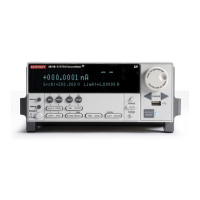12-16 Return to Section Topics 2600S-901-01 Rev. C / January 2008
Section 12: Instrument Control Library Series 2600 System SourceMeter® Instruments Reference Manual
Usage results = dataqueue.add (value, [timeout] )
value The data item to add.
timeout The maximum number of seconds to wait for room in the data queue.
results Assigns the value true or false based on the success of the add function.
Replace the word results with the name of the variable that you want to store
as the result indicator.
Remarks • You can only use the timeout value while adding data from a local data queue.
• The timeout value is ignored if the data queue is not full.
• The dataqueue.add function returns false if time-out expires before room is available
in the data queue or if the data queue is full and a timeout value is not specified.
• If the value is a table, a duplicate of the table and any subtables is made. The duplicate
table does not contain any references to the original table or to any subtables.
Example • dataqueue.add (10)
• dataqueue.add(10, 2)
• data_added = dataqueue.add (10, 3)
Use the following code to verify data was added to the data queue.
if not data_added then
print (“timeout error”)
end
dataqueue.CAPACITY
Attribute The maximum number of entries that you can store in the data queue.
Usage capacity = dataqueue.CAPACITY
capacity A custom variable that stores the maximum number of entries in
the data queue.
Remarks A read only attribute.
Example print(dataqueue.CAPACITY)
dataqueue.clear
Function Clears the data queue.
Usage dataqueue.clear()
Remarks • The dataqueue.clear command forces all dataqueue.add commands in progress to
time-out.
• The function deletes all data from the data queue.
dataqueue.count
Attribute Stores the number of entries saved in the data queue.
Usage count = dataqueue.count
count A custom variable that stores the number of entries in the data queue.
Remarks This is a read-only attribute.
dataqueue.next

